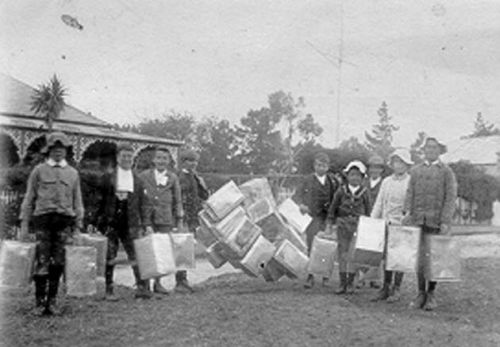 |
 |
|
Red Cross
Red Cross began in Tasmania in 1914, in response to the outbreak of the First World War. Branches were rapidly formed all around the state. Members raised large amounts of money, made many items of clothing, equipped four hundred beds and provided 3000 kit bags for the first voluntary hospital sent from Australia. Voluntary Aid Detachments (VADs) were formed, and after wounded Tasmanian soldiers arrived in August 1915, arranged for members to assist them. Red Cross organised transport of wounded men, and in 1915 the Red Cross Information Bureau was formed, with a card index for every soldier who left Tasmania. After the war ended, the need for fieldwork practically ceased. But Red Cross continued to help maimed soldiers through hospitals, hostels and convalescent homes. In 1931, Junior Red Cross branches were formed. Red Cross also began assisting the local community. After bushfires in 1933–34, those affected were given money, food and clothing. During the Depression Red Cross assisted other organisations to provide soup kitchens. In the Second World War Red Cross carried out its true functions, 'to provide funds and trained staff to ameliorate the sufferings of those who have become casualties, whether military or civilian'. Tasmania raised large amounts of money, sent fourteen ambulances overseas, opened hospitals, re-established the Information Bureau, and sent large shipments of clothing and foodstuffs to overseas victims of oppressors. Tasmania's 200 branches contained 15,000 members, and 10,000 in Junior Red Cross. In 1941, the Emergency Service consisted of personnel trained in First Aid, nursing, cooking, anti-gas precautions and transport to undertake civil defence duties. A War Emergency Committee bought storage space and a vehicle fleet. Women personnel were trained to take charge of the volunteers, the Blood Transfusion Service was reorganised, and returning invalid soldiers and prisoners of war were cared for. After the war, work continued in the convalescent home, and in assisting prisoners of war with employment and rehabilitation. Community activities included the library service and social workers for hospitals, handcraft services at therapy centres, and nutrition campaigns and holiday camps for young people. Relief at Home helped families whose homes were burned down, and distressed families referred by the Welfare Department. A Medical Loan Service issued wheelchairs and crutches, and Red Cross encouraged people to undertake home nursing courses. In 1947 the Lady Clark Convalescent Home became a rehabilitation centre and the St Mary's branch commenced a local ambulance service. After the 1967 bushfires, Red Cross oversaw a large-scale welfare programme, with other agencies providing staff, facilities, transport and material goods. In 1999 the Tasmanian Haven Centre was established to care for 400 Kosovar displaced persons. Red Cross managed the activities of the non-government section, collecting and distributing goods and donations from the public. Today Red Cross includes 50 branches with 1400 members, 92 youth groups with 850 young members, and 1300 volunteers, who work for over 100,000 hours each year. It meets international commitments through its Tracing and Refugee Service, Responses to Disasters, Dissemination of International Humanitarian Law and support for international projects. As well as the activities described above, it cares for homeless and at-risk youth and provides delivered meals, assistance to people with mental illnesses, medical transport, medical equipment hire, home units for the elderly, Telecross, and continues to run the Blood Bank. Australian Red Cross, Tasmania, remains as relevant as it was when it was formed in 1914. Ed Kremzer |
Copyright 2006, Centre for Tasmanian Historical Studies |
